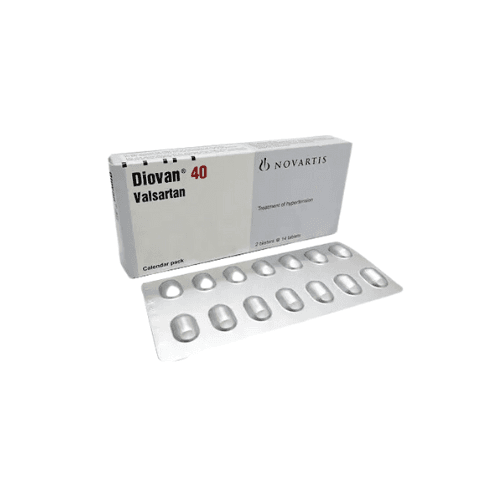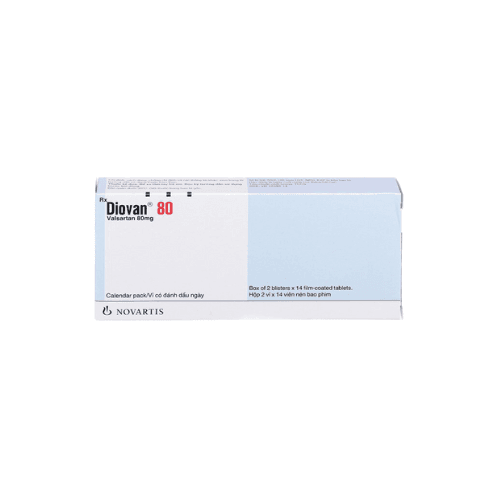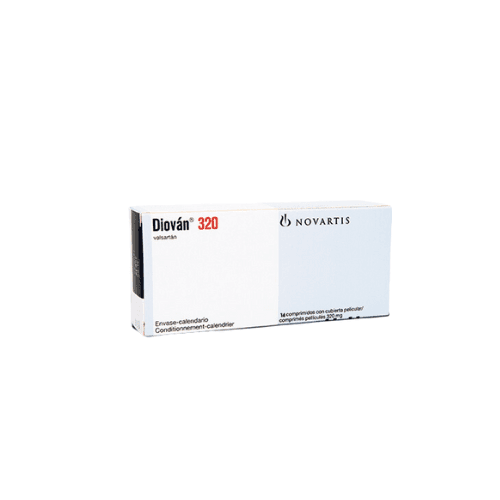Shipping with this method takes 3-5 days
Diovan® Tablets for Hypertension
Stock up and Save - Get 20% off when you buy 3 or more of any one product. Use code SAVE20 at checkout.
Coupon code cannot be combined with other offers. Sale applies to all products originating from Canada. Maximum allowable quantity equal to a 90 day supply per single order.
Price range: $68.99 through $70.99
Secure Encrypted Payments
Diovan is a prescription angiotensin II receptor blocker used to treat high blood pressure and some heart conditions. This page explains how it works, who it suits, and ways to access it with US delivery from Canada. You can compare Diovan price without insurance and review whether the generic could fit your budget.
What Diovan Is and How It Works
Diovan® contains valsartan, an angiotensin II receptor blocker (ARB). It helps relax blood vessels by blocking the effects of angiotensin II at the AT1 receptor. This lowers vascular resistance and can reduce blood pressure. In heart failure and after a heart attack, this class can help the heart work with less strain.
YouDrugstore is a licensed Canadian pharmacy in Manitoba. Pharmacists review prescriptions before dispensing.
This medicine is available as tablets for oral use. It may be taken with or without food. Food can reduce peak absorption, but the overall effect is usually not clinically meaningful. Follow your prescriber’s directions and the official label.
Many patients start or continue therapy under guidance for hypertension management. The treatment may be used alone or alongside other agents such as thiazide diuretics or calcium channel blockers. Ask your healthcare professional if combination therapy is appropriate for your plan.
Some patients are switched to Valsartan 160 mg tablets during dose titration based on response and tolerability. Always use one pharmacy label at a time to avoid confusion. Do not change strengths or schedules unless your prescriber instructs you to do so.
Who It’s For
This therapy is approved to treat high blood pressure in adults and in pediatric patients 6 to 16 years old. It is also used to treat heart failure (NYHA Class II–IV) to reduce hospitalizations, and to improve outcomes following a recent heart attack with left ventricular dysfunction. Your clinician will determine if this class is suitable based on your conditions and medicines.
It may not be appropriate during pregnancy, and it should not be used if you are hypersensitive to any component. It should generally be avoided with aliskiren in people with diabetes due to risk of kidney problems and high potassium. People with severe liver disease or biliary obstruction may need different options.
Some adults may begin on Diovan 40 mg when volume depleted, then gradually increase the dose as tolerated. Others may require higher strengths. Your prescriber will individualize the plan. Contact your clinician if you experience lightheadedness after starting or when doses change.
Dosage and Usage
Take tablets exactly as prescribed. For hypertension in adults, many regimens use once-daily dosing, commonly starting at 80 to 160 mg and adjusting up to 320 mg as needed. In heart failure, dosing often begins twice daily, then titrates to the target dose if tolerated. After a heart attack, lower twice-daily doses may be initiated and stepped up.
For pediatric hypertension, the dose is weight-based and typically given once daily. The healthcare professional will provide an appropriate plan using the child’s weight and response. Do not change the child’s dose on your own. Use a consistent daily time to help adherence; a pill organizer can help.
Swallow tablets with water. If a tablet is scored, your pharmacist can explain whether splitting is suitable for your prescribed strength. Avoid potassium salt substitutes unless your prescriber agrees. Rise slowly from sitting or lying if you feel dizzy.
Some clinicians transition patients to Valsartan 80 mg tablets during titration if blood pressure responses require adjustment. Do not take extra doses for missed tablets. Review the Medication Guide and talk to your prescriber before using any over-the-counter pain relievers that may affect blood pressure or kidney function.
Strengths and Forms
This treatment is supplied as film-coated tablets commonly available in these strengths: 40 mg, 80 mg, 160 mg, and 320 mg. Appearance may vary by manufacturer.
An ARB/thiazide combination is also marketed for patients who benefit from dual mechanisms. Examples include valsartan with hydrochlorothiazide at several strengths, such as a 160/12.5 mg pairing. Your prescriber may recommend a combination if one agent alone is not sufficient.
Some patients who need higher doses use Valsartan 320 mg tablets once daily. Availability can differ by supplier and region.
Missed Dose and Timing
If you miss a dose, take it when you remember the same day. If it is nearly time for the next dose, skip the missed dose and return to your regular schedule. Do not double up. Setting phone reminders or using a weekly organizer can reduce missed doses. Discuss frequent lapses with your prescriber; a simpler schedule may help.
Storage and Travel Basics
Store tablets in the original container or blister at room temperature, away from excessive moisture. Keep the cap tightly closed and out of reach of children and pets. Do not store in a bathroom. If the bottle includes a desiccant, leave it inside the container.
When traveling, pack medicine in your carry-on with a copy of your prescription label. Keep tablets in their labeled container to assist with security checks. Avoid extreme temperatures and direct sunlight. If you cross time zones, keep your dosing interval consistent; your clinician can help you plan a simple schedule. Dispose of any damaged or contaminated tablets.
Benefits
ARB therapy can lower blood pressure, which may reduce the risk of stroke and other complications when used as directed. In heart failure, it can help with symptoms and reduce hospitalizations. After a heart attack, this class may support better remodeling outcomes. Many people appreciate the once-daily option for hypertension and the flexibility to combine with other agents when needed.
Side Effects and Safety
- Dizziness or lightheadedness, especially when starting
- Headache or fatigue
- Diarrhea or abdominal discomfort
- Back or joint pain
- Cough, usually mild if it occurs
- Elevated potassium on lab tests
Serious effects are uncommon but can include kidney function changes, low blood pressure requiring care, and rare angioedema with swelling of the face, lips, tongue, or throat. This medicine can harm an unborn baby. If pregnancy is possible, discuss birth control and notify your prescriber right away if you become pregnant or plan to conceive.
Drug Interactions and Cautions
Tell your healthcare professional about all medicines and supplements. Important interactions include potassium-sparing diuretics or potassium supplements, which can raise potassium levels; lithium, which can accumulate; and NSAIDs, which may reduce the blood pressure effect and affect kidneys, especially in older adults or those dehydrated. Avoid dual renin-angiotensin system blockade unless directed by a specialist.
Use caution if you have kidney artery stenosis, severe liver disease, dehydration, or low sodium. Lab monitoring may include kidney function and potassium, especially after dose changes. Alcohol can enhance blood pressure lowering and dizziness.
For more background on medication combinations, see our article Drug Interactions. For broader blood pressure guidance, explore Hypertension resources.
What to Expect Over Time
Blood pressure reductions typically develop over days to weeks with consistent use. Your clinician may adjust the dose based on readings and tolerability. In heart failure or after a heart attack, follow-up is important to evaluate symptoms, labs, and kidney function.
Use a home blood pressure monitor to track values at similar times each day, as advised. Lifestyle changes such as limiting sodium, staying active, and weight management can improve results. Consistent adherence is key to maintaining benefits. Bring your monitor or a log to appointments for review.
For practical tips on broader treatment approaches, see Treat Hypertension and learn about heart health topics in our Cardiovascular collection.
Compare With Alternatives
Other approved ARBs and options may be suitable if you need a different profile or cost point. The generic molecule is available as Valsartan. Another ARB option is Cozaar® (losartan), often chosen when a prescriber prefers a different agent in the same class. Your clinician can help select the right therapy for your situation.
Pricing and Access
Brand and generic options are available with Canadian pricing and US delivery. You can check availability, see strengths, and compare options on this page. If you are tracking out-of-pocket spending, you may also review the Valsartan cash price as a benchmark for generic value. We support encrypted checkout for a smooth experience.
Ships from Canada to US with prescription validation. To see current offers, visit our Promotions page. For heart-related medicines beyond ARBs, browse our Heart Failure and Heart Attack sections.
Availability and Substitutions
Supply can vary by strength and manufacturer. If a specific tablet is unavailable, your prescriber may recommend the generic or a therapeutically similar ARB. Our pharmacists can work with your prescription to coordinate an appropriate substitution when authorized. We cannot guarantee dates for restock; your clinician’s guidance will lead decisions.
Patient Suitability and Cost-Saving Tips
This therapy suits many adults with hypertension, selected pediatric patients, and people with heart failure or post–heart attack needs. It may not be suitable for pregnancy, certain liver conditions, or when specific interacting medicines are required. People with kidney concerns or high potassium need close monitoring.
To reduce costs, consider multi-month supplies if your prescriber agrees. Automatic refill reminders can help you stay on schedule. Compare the brand with generic options and talk with your clinician about flexibility in dose strength. Some patients track expenses using the Valsartan 160 mg price as a planning reference for a common strength. If a new dose is needed, consolidating to a single tablet when possible may lower pharmacy costs and improve adherence.
Questions to Ask Your Clinician
- Is this ARB the right first-line option for my condition?
- How should I monitor my blood pressure at home?
- Which lab tests do I need and how often?
- What side effects should prompt a call or visit?
- Could a combination tablet with a diuretic help me?
- Do any of my current medicines interact with this treatment?
- If I plan to become pregnant, what alternatives should we consider?
Authoritative Sources
DailyMed: Valsartan (US Prescribing Information)
Novartis: Diovan Prescribing Information
Health Canada: Diovan Drug Product Database
Ready to order? Place your request with US shipping from Canada and prompt, express shipping with temperature-controlled handling when required. This information is educational and does not replace your prescriber’s advice or the official label.
Express Shipping - from $25.00
Prices:
- Dry-Packed Products $25.00
- Cold-Packed Products $35.00
Shipping Countries:
- United States (all contiguous states**)
- Worldwide (excludes some countries***)
Standard Shipping - $15.00
Shipping with this method takes 5-10 days
Prices:
- Dry-Packed Products $15.00
- Not available for Cold-Packed products
Shipping Countries:
- United States (all contiguous states**)
- Worldwide (excludes some countries***)
How does this ARB lower blood pressure?
It blocks the action of angiotensin II at the AT1 receptor. That reduces blood vessel constriction and lowers vascular resistance, which can bring down blood pressure. Some people need combination therapy with a diuretic or a calcium channel blocker. Your clinician will decide which regimen fits your medical history and goals. Keep taking it as directed and monitor your readings at a consistent time each day.
How long before I notice blood pressure changes?
Many people see gradual reductions over days to weeks with steady use, though timing varies by person, dose, and other medicines. Your healthcare professional may adjust the dose based on readings and side effects. Keep a home blood pressure log and bring it to visits. Lifestyle measures like lower sodium intake and regular activity can support the medicine’s effect.
Can I take it with other blood pressure medicines?
Yes, it is often combined with other agents when needed. Common partners include thiazide diuretics and calcium channel blockers. Your prescriber may avoid using it together with aliskiren if you have diabetes, or with certain potassium-sparing medicines due to high potassium risk. Do not add or stop medicines without guidance, including over-the-counter NSAIDs.
What side effects should I watch for?
Dizziness, headache, and fatigue are among the most reported. Diarrhea or back pain can occur. More serious but less common effects include low blood pressure, kidney function changes, high potassium, and rare angioedema. If you have swelling of the face, lips, tongue, or throat, seek care. Tell your clinician about any persistent or severe effects, especially after dose changes.
Is it safe to use during pregnancy or breastfeeding?
This class carries a boxed warning for fetal toxicity and should not be used in pregnancy. If you become pregnant, contact your prescriber right away. Discuss birth control if pregnancy is possible. For breastfeeding, data are limited and your clinician will weigh risks and benefits. Alternatives may be recommended depending on your situation.
What if I miss a dose?
Take the missed dose when you remember the same day. If it is almost time for your next dose, skip the missed dose and resume your regular schedule. Do not double up. Consider setting phone reminders or using a pill organizer to help prevent future missed doses. If you miss doses often, talk with your healthcare professional about simplifying your plan.
How should I store the tablets and travel with them?
Keep tablets in the original container, tightly closed, at room temperature away from moisture. Store out of reach of children and pets. When traveling, carry them in your hand luggage with the labeled container and a copy of the prescription label. Protect from extreme heat and sunlight. Keep your dosing time consistent across time zones as advised by your clinician.



